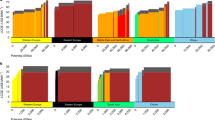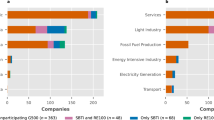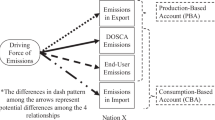Abstract
Using more renewable energy to make exported goods helps reduce carbon emissions from global trade. However, current global trade databases often lack precise data on how much renewable energy is used to produce traded goods, limiting insights into how this is changing over time. To address this gap, we develop a renewable energy featured final energy account (RE-FEA) that quantifies final energy (electricity and non-electric energy products) directly consumed by end-use sectors. This dataset covers 145 countries, 163 sectors and annual data from 2011 to 2022. From the dataset, we estimate that the share of renewable energy embodied in exports over total embodied energy rose from 8% to 13% over the period. Cleaner energy exports are concentrated among high-income and upper-middle income countries and in light industry and material manufacturing. This dataset fills gaps in current Multi-Regional Input–Output data and can improve the understanding of how global trade impacts sustainability.
This is a preview of subscription content, access via your institution
Access options
Access Nature and 54 other Nature Portfolio journals
Get Nature+, our best-value online-access subscription
$32.99 / 30 days
cancel any time
Subscribe to this journal
Receive 12 digital issues and online access to articles
$119.00 per year
only $9.92 per issue
Buy this article
- Purchase on SpringerLink
- Instant access to full article PDF
Prices may be subject to local taxes which are calculated during checkout





Similar content being viewed by others
Data availability
The RE-FEA database, comprising three distinct energy account categories (renewable energy, carbon-free energy and fossil fuel) for both REX3 and Eora datasets, and geographical and sectoral mapping matrices used to develop RE-FEA database are publicly available via Zenodo at https://doi.org/10.5281/zenodo.15826919 (ref. 53). Final energy consumption and national electricity mix data are derived from IEA Extended Energy Balances27 (https://www.iea.org/data-and-statistics/data-product/world-energy-balances). REX3 MRIO table can be downloaded via Zenodo at https://doi.org/10.5281/zenodo.10354283 (ref. 28). Eora MRIO table is available at the Eora Global Supply Chain Database (https://worldmrio.com/). The transport allocation share is available from ref. 15. Income group classification is available at https://datatopics.worldbank.org/world-development-indicators/the-world-by-income-and-region.html. Development stage classification of each country (region) is available at https://unctadstat.unctad.org/EN/Classifications.html. Source data are provided with this paper.
Code availability
The code for RE-FEA construction and MRIO analysis is publicly available via Zenodo at https://doi.org/10.5281/zenodo.15826919 (ref. 53).
References
Yang, L. et al. Environmental-social-economic footprints of consumption and trade in the Asia–Pacific region. Nat. Commun. 11, 4490 (2020).
Chen, G. Q. & Wu, X. F. Energy overview for globalized world economy: source, supply chain and sink. Renewable Sustainable Energy Rev. 69, 735–749 (2017).
Pan, A., Xiao, T., Dai, L. & Shi, X. Global transfer of embodied energy: from source to sink through global value chains. Sustainable Prod. Consumption 31, 39–51 (2022).
Yang, Y., Zhou, Y., Shan, Y. & Hubacek, K. The shift of embodied energy flows among the Global South and Global North in the post-globalisation era. Energy Econ. https://doi.org/10.1016/j.eneco.2024.107408 (2024).
Jiang, L., He, S., Tian, X., Zhang, B. & Zhou, H. Energy use embodied in international trade of 39 countries: spatial transfer patterns and driving factors. Energy 195, 116988 (2020).
Chen, B. et al. Global energy flows embodied in international trade: a combination of environmentally extended input–output analysis and complex network analysis. Appl. Energy 210, 98–107 (2018).
Wang, Q., Jiang, F. & Li, R. Assessing supply chain greenness from the perspective of embodied renewable energy—a data envelopment analysis using multi-regional input-output analysis. Renewable Energy 189, 1292–1305 (2022).
Wang, Q. & Liu, Y. India’s renewable energy: new insights from multi-regional input output and structural decomposition analysis. J. Cleaner Prod. 283, 124230 (2021).
Montoya, M. A., Allegretti, G., Sleimann Bertussi, L. A. & Talamini, E. Renewable and non-renewable in the energy-emissions-climate nexus: Brazilian contributions to climate change via international trade. J. Cleaner Prod. 312, 127700 (2021).
Zheng, S. et al. Assessment of the global energy transition: based on trade embodied energy analysis. Energy 273, 127274 (2023).
He, J., Yang, Y., Liao, Z., Xu, A. & Fang, K. Linking SDG 7 to assess the renewable energy footprint of nations by 2030. Appl. Energy 317, 119167 (2022).
Inter-Country Input–Output Tables (OECD, 2021); https://www.oecd.org/en/data/datasets/inter-country-input-output-tables.html
Huo, J. et al. Full-scale, near real-time multi-regional input–output table for the global emerging economies (EMERGING). J. Ind. Ecol. 26, 1218–1232 (2022).
Stadler, K. et al. EXIOBASE 3: developing a time series of detailed environmentally extended multi‐regional input‐output tables. J. Ind. Ecol. 22, 502–515 (2018).
Rasul, K., Schmidt, S., Hertwich, E. G. & Wood, R. EXIOBASE energy accounts: improving precision in an open-sourced procedure applicable to any MRIO database. J. Ind. Ecol. 28, 1771–1785 (2024).
Stadler, K. et al. EXIOBASE 3. Zenodo https://doi.org/10.5281/zenodo.14869924 (2025).
Andrew, R. M. & Peters, G. P. A multi-region input–output table based on the global trade analysis project database (gtap-Mrio). Econ. Syst. Res. 25, 99–121 (2013).
Aguiar, A., Chepeliev, M., Corong, E. & van der Mensbrugghe, D. The Global Trade Analysis Project (GTAP) data base: version 11. J. Glob. Econ. Anal. https://doi.org/10.21642/JGEA.070201AF (2022).
McDougall, R. & Chepeliev, M. An energy data base for GTAP. in Global Trade, Assistance, and Production: the GTAP 10 Data Base (ed Aguiar, A.) Chap. 11 (GTAP, 2021); https://www.gtap.agecon.purdue.edu/resources/res_display.asp?RecordID=6437
Wiedmann, T. An input–output virtual laboratory in practice—survey of uptake, usage and applications of the first operational IELab. Econ. Syst. Res. 29, 296–312 (2017).
Lenzen, M. et al. Implementing the material footprint to measure progress towards Sustainable Development Goals 8 and 12. Nat. Sustain. 5, 157–166 (2022).
Lenzen, M., Moran, D., Kanemoto, K. & Geschke, A. Building Eora: a global multi-region input–output database at high country and sector resolution. Econ. Syst. Res. 25, 20–49 (2013).
Lenzen, M., Kanemoto, K., Moran, D. & Geschke, A. Mapping the structure of the world economy. Environ. Sci. Technol. 46, 8374–8381 (2012).
Timmer, M. P., Dietzenbacher, E., Los, B., Stehrer, R. & De Vries, G. J. An illustrated user guide to the world input–output database: the case of global automotive production. Rev. Int. Econ. 23, 575–605 (2015).
Teodora, C. et al. World input–output database environmental accounts. Publications Office of the European Union https://doi.org/10.2760/024036 (2019).
Usubiaga-Liaño, A., Arto, I. & Acosta-Fernández, J. Double accounting in energy footprint and related assessments: how common is it and what are the consequences? Energy 222, 119891 (2021).
World Energy Balances (IEA, 2024); https://www.iea.org/data-and-statistics/data-product/world-energy-balances
Cabernard, L., Pfister, S. & Hellweg, S. Resolved Exiobase version 3 (REX3). Zenodo https://doi.org/10.5281/zenodo.10354283 (2024).
Cabernard, L., Pfister, S. & Hellweg, S. Biodiversity impacts of recent land-use change driven by increases in agri-food imports. Nat. Sustain. 7, 1512–1524 (2024).
Han, S. et al. Prospects for global sustainable development through integrating the environmental impacts of economic activities. Nat. Commun. 15, 8424 (2024).
Peng, K. et al. The global power sector’s low-carbon transition may enhance sustainable development goal achievement. Nat. Commun. 14, 3144 (2023).
Malik, A. et al. Polarizing and equalizing trends in international trade and Sustainable Development Goals. Nat. Sustain. https://doi.org/10.1038/s41893-024-01397-5 (2024).
Xu, Z. et al. Impacts of international trade on global sustainable development. Nat. Sustain. 3, 964–971 (2020).
Della Bella, S., Sen, B., Cimpan, C., Rocco, M. V. & Liu, G. Exploring the impact of recycling on demand–supply balance of critical materials in green transition: a dynamic multi-regional waste input–output analysis. Environ. Sci. Technol. 57, 10221–10230 (2023).
Owen, J. R. et al. Energy transition minerals and their intersection with land-connected peoples. Nat. Sustain. 6, 203–211 (2023).
Oswald, Y., Owen, A. & Steinberger, J. K. Large inequality in international and intranational energy footprints between income groups and across consumption categories. Nat. Energy 5, 231–239 (2020).
Brockway, P. E., Owen, A., Brand-Correa, L. I. & Hardt, L. Estimation of global final-stage energy-return-on-investment for fossil fuels with comparison to renewable energy sources. Nat. Energy 4, 612–621 (2019).
World Energy Balance Database Documentation (IEA, 2022); https://www.iea.org/subscribe-to-data-services/world-energy-balances-and-statistics
Statistics Division International Standard Industrial Classification of All Economic Activities (ISIC) Rev. 4 (United Nations, 2008).
Klenner, J., Lund, M. T., Muri, H. & Strømman, A. H. Combining fleetwide AviTeam aviation emission modeling with LCA perspectives for an alternative fuel impact assessment. Environ. Sci. Technol. 58, 9135–9146 (2024).
Klenner, J., Muri, H. & Strømman, A. H. High-resolution modeling of aviation emissions in Norway. Transp. Res. Part Transp. Environ. 109, 103379 (2022).
Kramel, D. et al. Global shipping emissions from a well-to-wake perspective: the MariTEAM model. Environ. Sci. Technol. 55, 15040–15050 (2021).
Kim, Y.-R., Steen, S., Kramel, D., Muri, H. & Strømman, A. H. Modelling of ship resistance and power consumption for the global fleet: the MariTEAM model. Ocean Eng. 281, 114758 (2023).
Open Data | Electricity & Climate. Ember https://ember-climate.org/data/ (2023).
Wiedmann, T. & Lenzen, M. Environmental and social footprints of international trade. Nat. Geosci. 11, 314–321 (2018).
Meng, J. et al. The rise of south–south trade and its effect on global CO2 emissions. Nat. Commun. 9, 1871 (2018).
Bruckner, B. et al. Ecologically unequal exchanges driven by EU consumption. Nat. Sustain. https://doi.org/10.1038/s41893-022-01055-8 (2023).
Xiao, H. et al. Global transboundary synergies and trade-offs among Sustainable Development Goals from an integrated sustainability perspective. Nat. Commun. 15, 500 (2024).
Chancel, L. Global carbon inequality over 1990–2019. Nat. Sustain. 5, 931–938 (2022).
Hong, C. et al. Land-use emissions embodied in international trade. Science 376, 597–603 (2022).
Zhang, Z., Li, J. & Guan, D. Value chain carbon footprints of Chinese listed companies. Nat. Commun. 14, 2794 (2023).
Estimating CO2 Emissions Embodied in Final Demand and Trade Using the OECD ICIO 2015: Methodology and Results vol. 2016/05 (OECD, 2016); https://www.oecd-ilibrary.org/science-and-technology/estimating-co2-emissions-embodied-in-final-demand-and-trade-using-the-oecd-icio-2015_5jlrcm216xkl-en
Cheng, Y. & Yang, Y. A database for identifying and tracking renewable energy embodied in global trade. Zenodo https://doi.org/10.5281/zenodo.15826919 (2025).
Acknowledgements
This work was funded by the Ministry of Science and Technology of the People’s Republic of China (2023YFB3906700; Y.Y.), National Natural Science Foundation of China (42130712, 42121001 and 72348003; Y.Y.).
Author information
Authors and Affiliations
Contributions
Y.Y. and Y.C. designed the study. Y.Y., Y.C. and J.P.H.P. conducted the analysis and wrote the paper. Y.Z. and X.Q. provided guidance on methods and calculation. Y.C., S.X., X.L. and J.X. collected data and provided support on visualization. L.Z. and H.Z. provided comments. Y.Y. and J.P.H.P. supervised the study. All authors discussed the results and commented on the manuscript.
Corresponding author
Ethics declarations
Competing interests
The authors declare no competing interests.
Peer review
Peer review information
Nature Sustainability thanks Anne Owen, Christina Prell, Narasimha Rao and Daniel Scholten for their contribution to the peer review of this work.
Additional information
Publisher’s note Springer Nature remains neutral with regard to jurisdictional claims in published maps and institutional affiliations.
Supplementary information
Supplementary Information
Supplementary Methods, Figs. 1–11 and Tables 1–15.
Source data
Source Data Fig. 2
Statistical source data.
Source Data Fig. 3
Statistical source data.
Source Data Fig. 4
Statistical source data.
Source Data Fig. 5
Statistical source data.
Rights and permissions
Springer Nature or its licensor (e.g. a society or other partner) holds exclusive rights to this article under a publishing agreement with the author(s) or other rightsholder(s); author self-archiving of the accepted manuscript version of this article is solely governed by the terms of such publishing agreement and applicable law.
About this article
Cite this article
Yang, Y., Cheng, Y., Poon, J.P.H. et al. A database for identifying and tracking renewable energy embodied in global trade. Nat Sustain (2025). https://doi.org/10.1038/s41893-025-01614-9
Received:
Accepted:
Published:
DOI: https://doi.org/10.1038/s41893-025-01614-9



